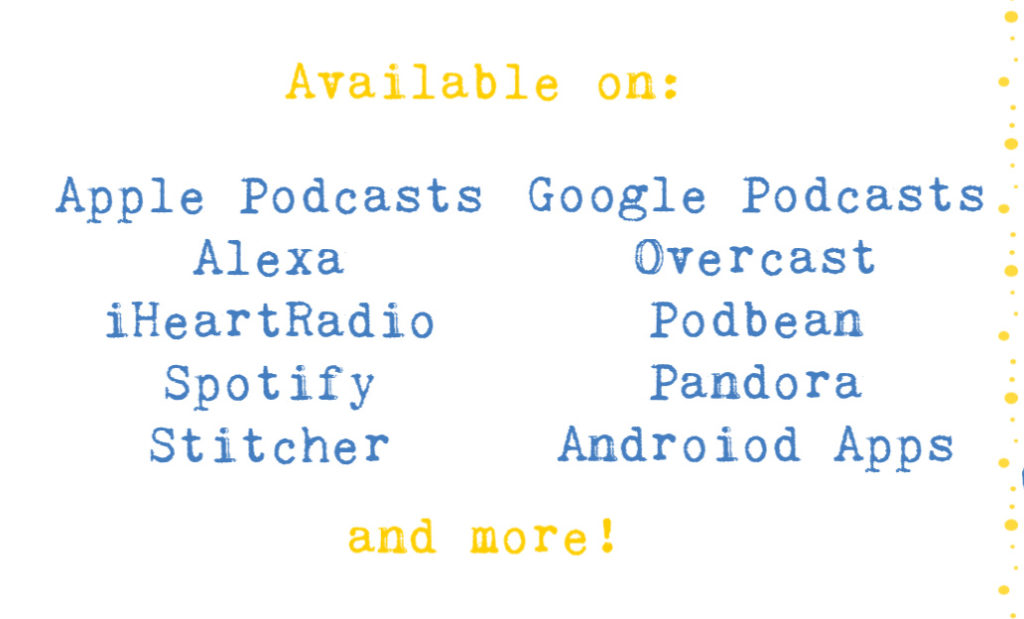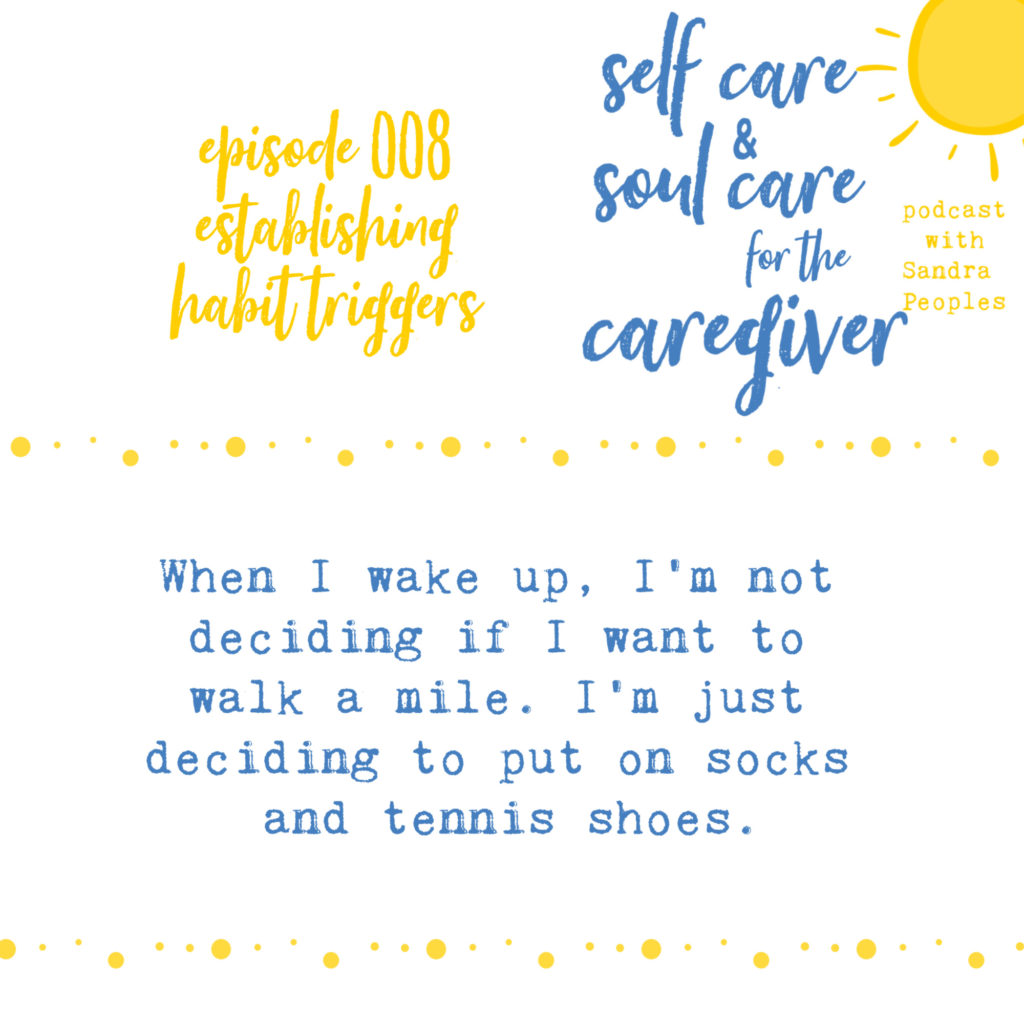Today we’re talking about habit triggers. When I first learned about these last year, they truly made a big difference in my day. That’s why I wanted to devote an entire episode to talk about them. We’re going to build off what we talked about in episode 6 on decision fatigue and episode 7 on creating the ideal week. Establishing habit triggers helps it all come together so your days move as smoothly as possible. You can also create habit triggers for your child with special-needs or your entire family! Everyone can benefit, especially you as the primary caretaker!
Listen to Self Care and Soul Care for the Caregiver on iTunes or the link at the end of the transcript.

Quick links from the episode:
- episode 6 on decision fatigue
- episode 7 on creating the ideal week
- Atomic Habits by James Clear
- http://bit.ly/prayformymarriage

Transcript:
This is self care and soul care for the caregiver, and I’m your host—Sandra Peoples. To us, self care isn’t a luxury, it’s a necessity. We want to take better care of ourselves so we’re able to care for our loved ones who rely on us.
You’re listening to episode 8, and today we’re talking about habit triggers. When I first learned about these last year, they truly made a big difference in my day. That’s why I wanted to devote an entire episode to talk about them. We’re going to build off what we talked about in episode 6 on decision fatigue and episode 7 on creating the ideal week. Establishing habit triggers helps it all come together so your days move as smoothly as possible. You can also create habit triggers for your child with special-needs or your entire family! Everyone can benefit, especially you as the primary caretaker, so let’s jump in!
In 2019, one of the first books I read was Atomic Habits by James Clear. It was the perfect book for January reading because it set me up to meet my goals for the year as I made some changes that would seem pretty insignificant, but that made a huge difference in my life.
James Clear writes, “If you want better results, then forget about setting goals. Focus on your system instead.” It’s the system that brings success. We’ve talked about how to set up successful systems through the episodes on decision fatigue and the ideal week, but establishing habit triggers will take it to the next level by making it even easier.
Even if you haven’t heard the term before, I bet once you understand the concept, you’ll see the habit triggers you’ve already established. Here’s the definition: A habit trigger is something that happens that produces the same result over and over again.
When a text message pings on your phone, you pick it up to read. The trigger is the ping; the habit is responding by picking it up. Let’s think of even more: the gas light comes on in your car, so you fill up the tank. The dog goes to the door and whines, so you let him out. Your husband comes to bed, so you roll over for a good night kiss. There’s a trigger and a response that happen so frequently, they become a habit.
When we talked about the ideal week in episode 7, those habits were formed based on the day or time. It’s Monday at 9:00 am, so I’m going to check my email. Or it’s Sunday at 8:50, so let’s leave for church. But habit triggers aren’t based on time and day. They happen as a result of what came before.
Can you think of some others in your daily routine? Now let’s figure out how to use them to our advantage to reach the goals we have.
James Clear explains that one of the best ways to build a new habit is to identify a current habit you already do each day and then stack your new behavior on top. Something you already do is the trigger for what you want to do.
Here are a couple examples,
- When we sit down to dinner, we will say a prayer.
- When the bus pulls up in front of the house at the end of the school day, I will put my phone away so I’m ready to give my child my full attention.
You can keep going with the habits, stacking them on top of each other until you’ve built the routine you want. Here’s an example of that:
- After I finish eating breakfast, I will put my plate and any other dishes that are in the sink into the dishwasher.
- After I load the dishwasher, I will wipe down the counter.
- After I wipe down the counter, I will look at my menu plan for dinner and see if there’s anything I can do right now, like lay out frozen meat or cut vegetables.
See how the habits stack on top of each other?
There are a couple keys to making this successful. First, make it as specific as possible. Don’t say “when I wake up, I’m going to do this.” Do you mean right after you wake up? Or after you go to the bathroom? Or after you’ve greeted your family? After you pour the first cup of coffee? Be as specific as you can be.
Second, match the trigger to the frequency you want to do the new habit. Do I want to start a new habit of exercising every day? Then my trigger should happen every day. Do I want to do it three times a week? Then my trigger should happen on those days.
Third, as we talked about with trigger stacking, make the big decision the easiest one to make because you’ve already made the smaller decisions that lead up to it. Break it down as much as you can to increase your success.

Let me share a very specific example from my life. I need to walk more. My goal is 1 mile three days a week. So what has to happen before I can go for a walk? Well, I have to put on the right clothes and shoes. In Houston I pretty much wear flip flops year round, especially around the house. I don’t want to walk a mile in those unless I’m on the beach. So tennis shoes and socks are required. And I need to drive somewhere to do it, like a park. And if I’m walking at a park, I need headphones so I can listen to a podcast. And I want to download that podcast before I leave so I’m not using data. Do you see what I’m doing? I’m thinking of every excuse I have not to walk and finding a solution for that excuse.
Here’s the new habit I’ve established: on MWF, I take James to another town for therapy. On the way home I pass a park where I can walk. So before all that, when I’m getting dressed, I put on my sports bra and socks and tennis shoes. After I’ve tied them, I look at my phone to download a podcast. I then grab the earbuds and get myself and James in the car to leave. I’ve already done the work of getting dressed, getting prepared with a podcast, and driven to a spot where I can walk. I stacked those triggers so the decision to walk is an easy one. It becomes my habit. The decision fatigue we talked about in episode 6 is eliminated. When I wake up, I’m not deciding if I want to walk a mile. I’m just deciding to put on socks and tennis shoes. And since I already have them on as I drive right past the park after dropping off James, I might as well walk.
 Let me give you one more quick application before we wrap up. I think this whole concept can be used in reverse too. Here’s what I mean: I’m trying to drink fewer Dr Peppers. So instead of opening the fridge and finding a cold one ready for me each morning, I make it hard to get one. I don’t buy them at the grocery store. Since we live in a parsonage, which is a house owned by our church on the church property, I do have access to coke machines where I could buy one. But that means I have to find change and be willing to walk to another building. Since I like Dr Pepper first thing in the morning like for breakfast, I’m usually not wearing clothes that I want to leave my house in to walk around our church campus. Most days it’s just not worth it. And on days I’m willing to put all that effort into getting one, I figure I deserve it.
Let me give you one more quick application before we wrap up. I think this whole concept can be used in reverse too. Here’s what I mean: I’m trying to drink fewer Dr Peppers. So instead of opening the fridge and finding a cold one ready for me each morning, I make it hard to get one. I don’t buy them at the grocery store. Since we live in a parsonage, which is a house owned by our church on the church property, I do have access to coke machines where I could buy one. But that means I have to find change and be willing to walk to another building. Since I like Dr Pepper first thing in the morning like for breakfast, I’m usually not wearing clothes that I want to leave my house in to walk around our church campus. Most days it’s just not worth it. And on days I’m willing to put all that effort into getting one, I figure I deserve it.
Now it’s time to apply what we’ve talked about today. Think about what habit you want to start and how to create triggers to make you more successful at meeting that goal. Do you want to read your Bible more consistently? Download a Bible reading app so when you sit down with your coffee in the morning, you don’t have to find your Bible. You just open the app that’s on the phone already in your hand. Or, keep your Bible next to the spot on the couch where you sit do drink your coffee and pick it up instead of the remote. Create them for your family as well. Decide you will start sharing one thing you’re thankful for each night at dinner. The person who says the prayer goes first. Oh, and here’s one I thought of that you can do right now—subscribe to this podcast so next Monday it will download to your phone and when you drive home from getting everyone where they need to be, you can listen to it in the car.
Let’s pray together for your next steps: God, thank you for the patterns we see in our world each day. The sun comes up, moves across the sky, and goes down again. And we get up, move through our days, and lie down again. Help us to fulfill what you have called us to do by creating habits and easy rhythms for ourselves and our families. We praise you for the opportunities You give us to love and live well. In Jesus’ name we pray, amen.
If you’re listening to this episode in real time, the last week of January, I have a special invitation for you. On Feb. 1stI’m kicking off one of my favorite series: 14 days of prayer for your marriage for special-needs parents. This is the 3rdyear I’ve done it, and each year I’m amazed at the praise reports I hear from people who participate. If you sign up, you’ll get an email each day with a focus verse, short devotional, and prayer to pray for you and your spouse. If you want to celebrate Valentine’s Day by focusing on strengthening your relationship, then join me for this series. You can sign up at bit.ly/prayformymarriage The link is in the show notes over on sandrapeoples.com if you need it.
Thanks for joining me as we talked about habit triggers and using them to make life easier for ourselves as caretakers. I’ll be in the Facebook group talking more about them this week, so make sure you’re in the group self care for the special-needs mom. We’ll cheer you on as you create your own habit triggers!
Remember, self-care isn’t selfish. It’s important for us to take care of ourselves so we can care for the loved ones God has entrusted to us. Thanks for listening and I’ll meet you back here next Monday!


